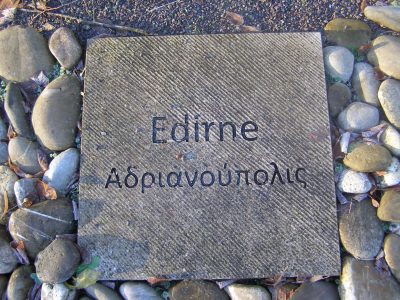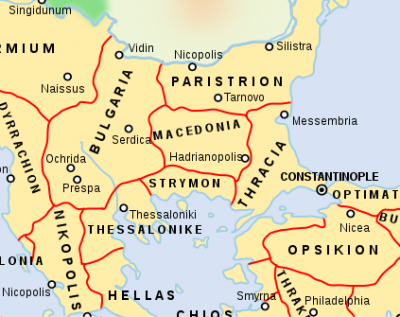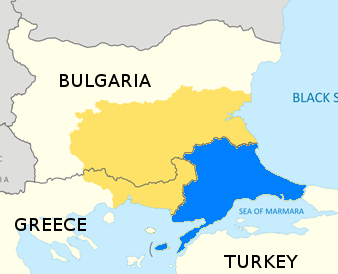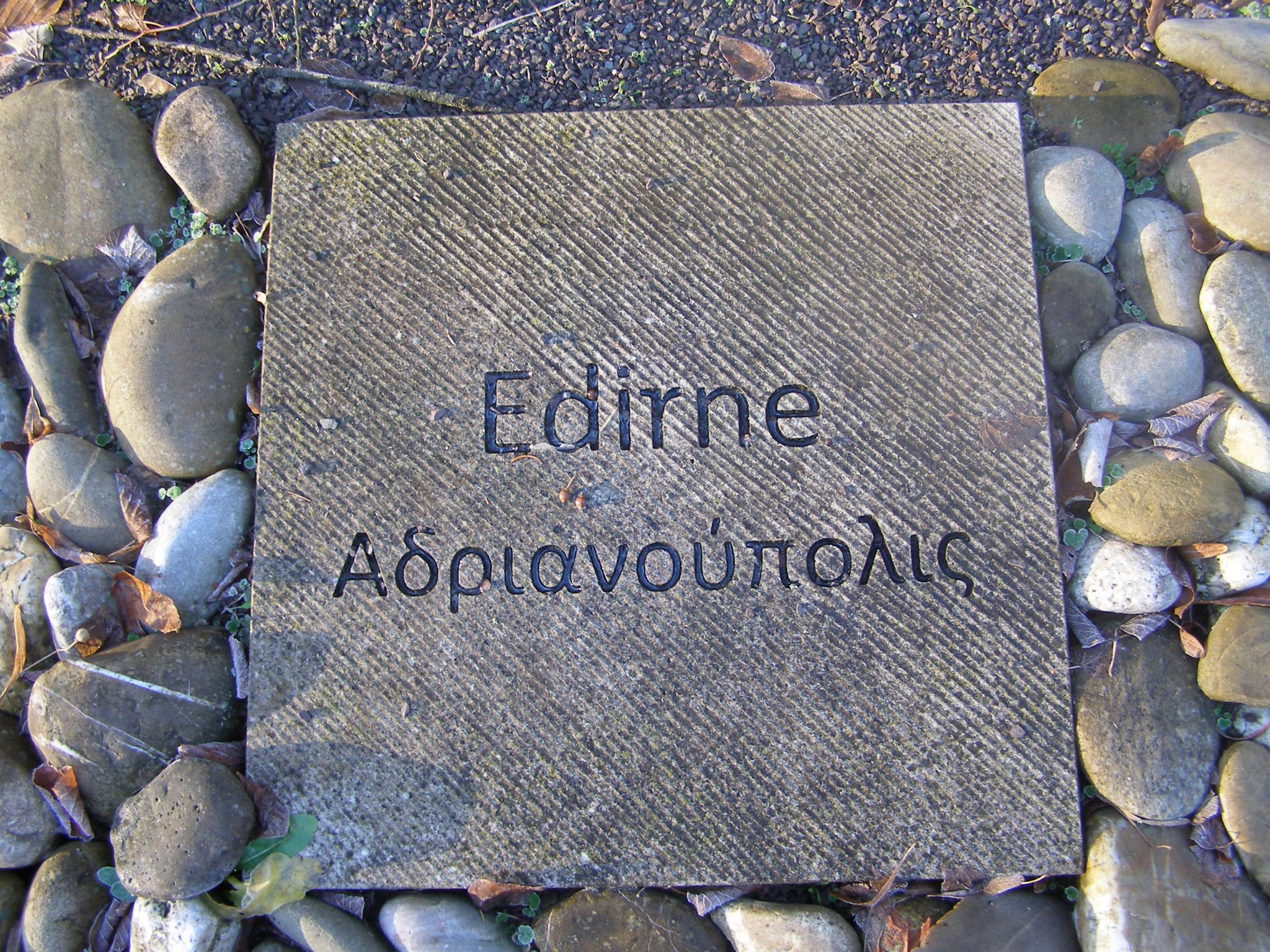
Toponym
The capital city of Thrace was founded as Hadrianopolis (Adrianople in English; Grk.: Ἁδριανούπολις), named after the Roman emperor Hadrian, on the site of a previous Thracian settlement named Uskudama. The Ottoman toponym Edirne (أدرنة) derives from the Greek name.
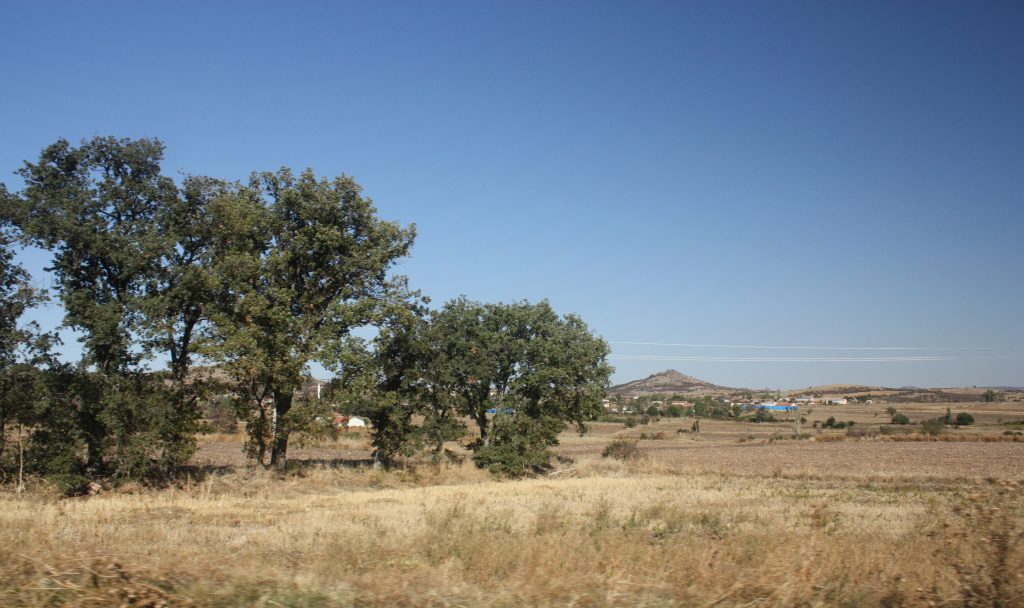
Administration
Adrianople was conquered by the Ottomans in 1361 or after 1366 and was the capital of the Ottoman Empire until the conquest of Constantinople. The Eyalet of Adrianople or Edirne comprised almost all of the historical geographical region of Thrace. It was constituted from parts of the eyalets of Silistra and Rumelia in 1826, comprising the six sancaks of Nevahi-i Erbaa (capital: Çatalca), Tekfürtaği (Rodosto) or Vize, Gelibolu (Gallipoli), Edirne (Adrianople), Filibe (mod. Plovdiv) and Islimiye (mod. Sliven) or Eski Zagra (Stara Zagora).
Until the First World War, almost all territories outside the present borders of Turkey were lost. The city of Edirne (formerly Adrianople) was the capital of the vilayet.
The Ottoman province of Adrianople covered a territory of 67,800 square kilometers until 1878 and comprised eight sancaks:
- Sancak of Adrianople (now Edirne) (Adrianople, Cisr-i Mustafapaşa, Kırcaali, Dimetoka (Didymoteicho), Ortaköy, Cisr-i Ergene, Havsa. It had the five kazas of Kırkkilise, Baba-yı Atik, Beykar Hisar, Maa Hatunili-Kızılağaç (its centre was Kızılağaç) and Ferecik. Kızılağaç went to Yanbolu sancak of Şarki Rumeli Vilayeti, Ferecik went initially to Gelibolu in 1876, later to Dedeağaç and was demoted to a nahiye in 1878, Kırkkilise, Baba-yı Atik and Beykar Hisar went to recreated Kırkkilise sancak in 1878. Beykar Hisar was demoted to nahiye in 1879.
- Sancak of Kırklareli (since 1878; Kırkkilise; Grk.: Saranta Ekklisiès) with the seven kazas of Kırkkilise, Tırnovacık, Lüleburgaz, Vize, Ahtabolu, Midye, Baba-yı Atik. Most of Tırnovacık and Ahtabolu were ceded to Bulgaria in 1913. Saray separated from Vize and became kaza in 1916.
- Sancak of Rodosto (mod. Tekırdag; Tekfürdaği) with the four kazas of Tekfürdağı, Çorlu, Malkara, Hayrabolu. It had also kazas Vize, Lüleburgaz and Midye till 1879, which then went to the recreated Kırkkilise sancak.
- Sancak of Gelibolu (Gallipoli) with its five kazas of Gelibolu, Maydos, Şarköy, Mürefte, Keşan. It had also Enez and Gümülcine kazas till 1878. Gümülcine promoted to sancak in 1878. Enez went to Dedeağaç sancak. Finally İpsala (promoted to kaza) and Enez returned to Gelibolu in 1913.
- Sancak of Dedeağaç (1878-1912) with the three kazas of Dedeağaç, Sofulu (Grk.: Σουφλί – Soufli), and Enez (Grk.: Ainos).
- Sancak of Gümülcine (Komotini; 1878-1912) with its six kazas of Gümülcine, İskeçe, Koşukavak, Ahiçelebi, Eğridere, Darıdere. The whole sancak was ceded to Bulgaria, with a small part to Greece in 1913.
- Sancak of Filibe (Plovdiv) with its eight kazas of Filibe, Pazarcık, Hasköy, Zağra-i Atik, Kızanlık, Çırpan, Sultanyeri, Ahiçelebi (until 1878, then it became part of Eastern Rumelia)
- Sancak of Slimia with its eight kazas of İslimye (Sliven), Yanbolu, Misivri, Karinabat, Aydos, Zağra-i Cedid (Stara Zagora), Ahyolu, Burgaz (until 1878, then became part of Eastern Rumelia)
After 1878, the Vilayet of Adrianople covered a territory of 38,900 square kilometers, comprising the six sancaks of Adrianople (Edirne), Kırklareli, Rodosto, Gelibolu,Dedeağaç, and Gümülcine.
Population
| Ottoman population data were not based on linguistic or ethnic but on ethno-religious affiliations. According to the Ottoman census of 1906/7, the overall population of 1,134,000 in the province consisted of 619,000 Muslims, 341,000 Greeks (Greek Orthodox Christians), 120,000 Bulgarians, 26,000 Armenians and 24,000 Jews.[1] The Belgian magazine Ons Volk Ontwaakt (‘Our Nation Awakes’) of 21 December 1912 estimated an overall population of 1,006,500 inhabitants, comprising of 250,000 Muslim Turks, 115,000 Muslim Bulgarians, 15,000 Muslim Roma people, 370,000 Orthodox Bulgarians, 220,000 Orthodox Greeks, 30,000 Orthodox Armenians, 3,500 Orthodox Albanians, and 3,000 Orthodox Turks.
In terms of canon law, Thrace consisted of several Greek Orthodox bishoprics. According to the Ecumenical Patriarchate at Constantinople, the Diocese of Adrianople comprised fifty-two communities, containing a population of 51,196 inhabitants[2]; the Greek Orthodox Diocese of Chorloa (Grk.: Tyroloi; Trk.: Çorlu) was composed of eighteen communities, containing a population of 16,735.[3] That of the Diocese of Kırkkilise (Grk.: Saranta Ekklisiès) in the sancak of same name (since 1878: Kirklareli) numbered twelve communities with 25,427 inhabitants.[4] The Diocese of Enos is divided into two parts — those of Enos and Dedeağaç. It comprised seventeen communities with a population of 10,057 Greeks.[5] The Diocese of Vize (Grk.: Bizye) had a Greek Orthodox population of 28,783, divided into twenty-five communities.[6] The Diocese of Heraclea consisted of 74,036 Greek Orthodox Christians in 82 parishes.[7] For all Eastern Thrace the statistics of the Ecumenical Patriarchate of 1912 mentioned an overall population of 1,669,500; of these, 604,500 (36.2%) were Turks, 655,600 (39.27%) Greeks, 71,800 (4.30%) Bulgarians, and 337,600 (20.22%) “others”.[8] “(…) the Armenian community in the vilayet of Edirne developed from the sixteenth century on, when the famous architect Sinan called on 250 of his compatriots to help build the mosque of Sultan Selim in Edirne. At the turn of the seventeenth century, Armenians from Kemah and Erzincan areas, victims of the series of famine years that had followed the looting of the celali (revolts), also settled in Tekirdağ and Malgara on the shores of the Sea of Marmara and further west in Çorlu and Silivri.”[9] According to the Armenian Patriarchate of Constantinople, there lived 30,316 Armenians in nine localities of Thrace on the eve of the First World War, maintaining 14 churches and monasteries and 15 schools with an enrolment of 2,438 pupils.[10] HistoryThe area around Edirne has been the site of numerous major battles and sieges, since the days of the Roman Empire. The vagaries of the border region between Asia and Europe gives rise to Edirne’s historic claim to be the most frequently contested spot on the globe. DestructionMost of Eastern Thrace came under Ottoman rule in 1361, well before the Byzantine capital, Constantinople, fell to the Ottomans in 1453. In the 19th century, it became a bone of contention between the Ottoman Empire and the Balkan states of Greece and Bulgaria, the latter supported by Russia. Also in the course of the ten-year Ottoman genocide of indigenous Christians, Eastern Thrace was the first victim. Political persecutions against Greek Orthodox Eastern Thracians began as early as 1911. The Balkan Wars of 1912 and 1913 are considered by historians and genocide scholars to be the birth of widespread ‘ethnic’ warfare with massive flight and expulsion processes unknown in Europe until 1914. The expulsion of undesirable ethnic groups served as a pre-planned main objective. [11] Archbishop Germanos of Constantinople wrote in a letter of 19 May 1914 about the intention of the regime to annihilate by deportations: “It appears, however, that the Christians are doomed to undergo hard trials such as they never experienced even during the more gloomy days of servitude. Outrages and crimes committed of late, with the complicity of the authorities, against the Christian populations of Thrace and the horrible cruelties perpetrated against the Christians of Asia Minor, leave no doubt in our minds that the Orthodox population of the East has to contend with a systematic and mature plan which menaces the population with complete annihilation. As a matter of fact, the brutal expulsion of entire Christian populations of towns and villages in Thrace is being carried out, so that Thrace, a European province which has preserved for the last two thousand years its Christian character, and numbering sixteen Bishoprics, with a very dense Christian population, surpassing even up to this day the Moslem element, runs the risk of rapidly becoming Turkish and Moslem Province should things be allowed to take their free course.”[12] The Ottomans’ disintegrating multiethnic state was to be stabilized through mono-ethnicization; assimilation, resettlement or dispersal of non-Turkish ethnicities, and, in the case of the Greeks and Armenians who were considered unassimilable, physical extermination were considered tried and tested means. In Eastern Thrace, the ruling nationalists of the Committee for Union and Progress (C.U.P., alias Young Turks) learned that, from the point of view of sustainable population policy, deportations designed as death marches were more effective, because they were deadlier, than expulsions: Those Greeks who fled from Eastern Thrace to Greek territory or were expelled across the border usually returned after the end of the war. However, of those Eastern Thracians deported to the interior of Asia Minor, about half perished. According to the Greek historian Konstantinos Vakalopoulos, the Greek population in Eastern Thrace before the Balkan Wars numbered more than 350,000. Of those, 100,000 had been deported into the interior of Asia Minor or Central Anatolia. Only 54,000 of the deportees returned after the Ottoman war capitulation of 30 October 1918. Vakalopoulos concludes that the other deportees had died as result of forced labor and diseases. [13] A Swiss contemporary, the historian and journalist Samuel Zurlinden (1861-1926), wrote during the First World War: “(…) that the Young Turks were determined to carry out their Turanian and pan-Islamic program was first felt by the Greeks in 1913. In Thrace, the remaining part of European Turkey, a fierce persecution of Greeks suddenly began. Greeks, like Bulgarians for that matter, were robbed of their money and goods and chased across the border.” [14] Between 1912-1913 alone, 15,690 Greeks were massacred in Eastern Thrace.[15] In the Diocese of Vize, the situation in 1913 is described by the Ecumenical Patriarchate of Constantinople in the following way: “Apart from the former great losses sustained under the Bulgarian regime in the form of requisitioning of cattle, the pillage of corn and burning of the Bishopric, together with its furniture and library, this district was greatly damaged during the retreat of the Turks and their re-occupation of Thrace, when six churches, one school, 624 houses and shops were burnt, and 186 inhabitants of various communities murdered. Renewed plunder followed, in which the Turkish officials took a prominent part under pretext of finding out what goods were taken by the Christians from the Turks, so that they managed to strip the Christian population completely of their property.”[16] A 3 November 1912 report describes how the Ottoman Army at Aivali near Lüleburgaz (Grk.: Arkadioupolis) massacred 167 Greek men, women, and children. Four hundred Ottoman cavalry destroyed the Greek villages of Yagato and Golcuk, Bayramiç and Elmalı in the Malgara region. At Keşan (Grk.: Kessani), 300 Greeks were massacred.[17] In July 1913, the Ottoman Army massacred Greeks at Gönence, Tekirdağ, Hayrabolu, Hasköy, Hemit, Kürtüllü and Bayramtepe and committed widespread looting and rape.[18] The burning of churches and entire villages usually coincided with massacres.[19] In the region of Malgara alone, 18 Greek villages were wiped out. The Greek Patriarchate protested vigorously both to the Ottoman Government and foreign consulates but with no effect. Even before the Ottoman entry into the First World War (November 1914), state instigated violence against Greeks increased in Eastern Thrace. The ‘Black Easter’ (Μαύρο Πάσχα) of 6 April 1914 marks this development and is therefore commemorated by the descendants of the victims since 2006 as a day of remembrance of the genocide against the Greek Orthodox Eastern Thracians. On that day, 200 Greek families from Binkılıç (Grk.: Strantza) were deported. After being beaten, stripped of their valuables and having large sums of money extorted from them, Turkish corporals and gendarmes with swords drawn, ordered them to leave. The expulsed arrived at Marmara Ereğlisi (Grk.: Ἡράκλεια – Herakleia; Heraclea) where they were boarded onto the S.S Markella and deported. Deportations and atrocities continued in Eastern Thrace throughout September 1914 and in 1915, when also crimes of eliticide were committed against Greek Orthodox and Armenian local and regional notables. Between January and April of 1915, there were reports of Greeks being buried alive and arrests of people on dubious charges. Priests, teachers and entire families were thrown in jail[20]. In January 1915, two Greeks were killed in the village of Kerdeli. Seventeen Greeks from Kırkkilise (today Kırklareli) and Vizyi (Vize) were arrested as suspects for the murder of the son of the Governor. They were buried alive in graves which they were compelled to dig. The teachers and priests of the city of Kessani were thrown into jail. In March 1915, the Rev. Apostolos, a priest of the village of Varnitza, was strangled in the prison of Kessani. Numerous families were imprisoned at Chora. The women were thrown on the ground and beaten by gendarmes with whips on the soles of their feet, in order that they might disclose the hiding places of their husbands. During the deportation of the town of Skopos in 1915 the following persons were slain by gendarmes; Papakyriakos, Arist Constantopoulos, P. Valantsanidis, Z. Phloros, Zariphiadis, Th. Kokkalas and Simos Simopoulos. Five prokritoi (elders) of Skopos were arrested and subsequently murdered on 11 September 1915. “At the time of the departure of the unfortunate Greeks from Skopos, a thoroughly Hellenic virile community of Thrace, who were abandoning their homes and properties, with lamentations and wailing, under the funeral peals of the bells of their churches, which the barbarians were ringing to the accompaniment of wild cheers as an indication of the funeral of the village of Skopos, some of their notables and educated persons, such as Papakyriacos, the Constantopoulo brothers, Pelopidas Davajanidi, Zaphirios Zaphiriades and Theodore Kokalas, were seized and after being led a short distance out of the village were beheaded like sheep and their bodies were left there to become the prey of dogs and vultures. Two days before the Turks had arrested another of the most prominent and educated citizens, namely, Simos Simopoulos, whom they beheaded outside of the town, after subjecting him to unheard of tortures.”[21] “Shortly after the re-occupation of Thrace by the Turks, three persons were massacred outside the small market town of Lüleburgaz, the two belonging to Rodosto, and one to Tourghout Bey. On the 3rd of April, 1915, George Tzimitras was arrested and cruelly beaten; £360 were taken away from him in the presence of the tax collector, Tzobanoglou [Çobanoğlu], and the inspector of tithes, Abdourahman Bey. On the next day the notable of the village, Theodores Kotzabasis, was massacred, and his two sons thrown into prison. On the 11th, the notables, Zacharias Kyriazides and loannis Ignatiadis, were ordered under pain of death to leave. On the 27th April, a systematic attack against the town commenced. Firing was heard every day in which officers, government officials and irregulars equally took part. On the 3rd of July, Chrisoverghi, 35 years old, was massacred. On the 6th, Verghouhis Sfanghilis was wounded. On the 27th, Sultan Effendi threatened to take Constantino Kyriazidhi’s life. Thus, owing to constant and daily threats, ill-treatment and plundering, many families decided to quit the place. Their houses, fortunes and fields, were also seized by the Government and handed to the Moslem emigrants.”[22] “The greater part of the inhabitants of Malgara are in jail, where they endure great sufferings. The representative of the Bishop and 23 prominent men were taken to Adrianople, and on their way beaten by the gendarmes. In April 1915, two Greeks were hung in Adrianople without any reason.”[23] “When, in July 1918, Eastern Thrace was reconquered by the Turks, the Greek population, especially the peasants, suffered all kinds of martyrdom not only on the part of the irregulars but also of the regular Turkish troops. In March, 1914, began the unmerciful persecution of the Christians, which directly inspired by the then Governor of Adrianople, Hadji Adil Bey conducted by Government officials, and carried out by bands of gypsies and Musulman Albanians, forced the Greek population to leave their country.”[24] “According to an Armenian source, several thousand of the more than 30,000 Armenians in the vilayet of Edirne escaped deportation thanks to the energic intervention of the Bulgarian authorities.”[25] In 1919, the Ecumenical Patriarchate concluded: The Diocese of Adrianople “is the one that suffered the most from the atrocities of the Balkan War, the savage persecutions of 1914, and the consequences of the Turk and Bulgarian alliance of September 1915. All that nature could devise in the way of unmerciful bastinado, unjustified arrests, imprisonment of peaceful, well-to-do people, with the sole object of extorting money from them, seizure of fortunes, requisitioning of houses and shops, etc., etc., all were put into practice, during the Bulgarian occupation of Thrace, with a view to exterminating the Greek element there, such action being not only tolerated, but also promoted by the highest Bulgarian officials.”[26] |
|
